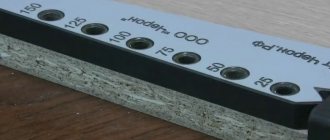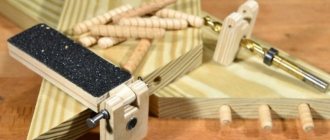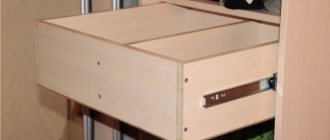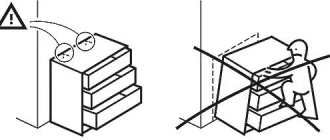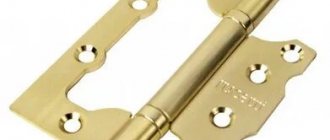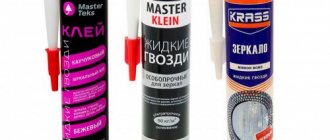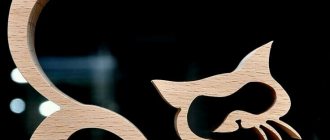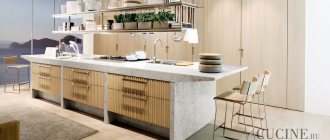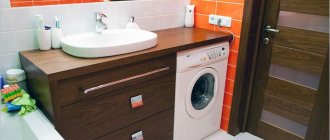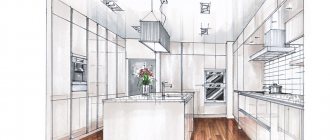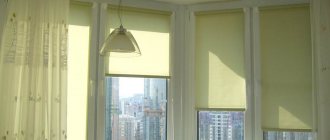Very often, when repairing furniture or assembling it, you need to accurately drill holes for the firmmat, dowel and other fasteners. If you drill a sheet of chipboard, it is almost impossible to do this with a simple drill, since the hole breaks and it is not always possible to make a right angle. Therefore, for such work you must have a tool called a conductor.
Classification of conductors
The main function of jigs is to ensure straightness in drilling wooden surfaces throughout the entire depth of the hole. Such devices are used quite often in metal processing and, as a rule, are supplied directly with the machine. Due to the need to create such holes in furniture production in large quantities, such devices are in great demand among craftsmen.
There are the following types of conductors:
- Invoices. This type does not require fixation before starting work. They are practical and simple, but they should only be used with one hand unless the drill is mounted on a special stand. You can make such a conductor yourself easily and simply, but it must be used in chipboards.
- Rotary. With their help, you can make two holes in planes that are adjacent to each other. This operation is performed thanks to a folding bracket.
- Jig for drilling holes at an angle. This option is used in highly specialized industries. It can be used to drill holes at an angle. Sometimes used in conjunction with slip-on conductors.
- Sliding. They are designed to drill holes in multiple locations while keeping the original settings the same. They are mainly used by professionals and require little experience to operate successfully.
If the jig has sufficient rigidity, then it can be used not only on flat planes, but also for curved pipes, etc. In this case, it is secured with a clamp. But under no circumstances should it be used for fastening on wooden surfaces, as it can damage the furniture. You can buy it in a store, or you can also make it yourself.
The jig is in fact a template for making holes, with the help of which such work can be done with maximum accuracy. Due to the simplicity of the structure, they are often used not only in the areas of furniture production. In particular, they are actively used in the field of mechanical engineering for drilling holes in various workpieces, etc. We should not forget about the furniture industry, where such a device is used for various needs when assembling furniture fittings.
Types of connection
When connecting wooden parts, you need to remember an important point - a thin part is always attached to a thick one, but not vice versa.
According to the relative arrangement of the elements, the following methods of connecting wooden parts are distinguished:
- extension - increasing the height of a part;
- splicing - elongation of the workpiece;
- consolidation—increasing the element’s width;
- knitting - joining at an angle.
The most commonly used methods for joining wooden parts in furniture making are:
- gluing;
- "dovetail";
- end-to-end;
- grooved;
- overlap;
- deaf on spikes;
- through tenon.
Let's look at the technologies of some connections in more detail.
Features of self-production
When designing a conductor for confirmation, it is necessary to correctly calculate what functions it will have to perform in the future. It should be done for the most commonly used fasteners in the house. If such a device is required by furniture makers for constant work, then it is better to buy a factory model, which is distinguished by great precision. In addition, manufacturers often include additional fasteners, stops and templates in the kit.
Making a tap for wood carving with your own hands
To cut carvings in wood, you may need a wood tap; this tool will most likely not be cheap, and it can be quite difficult to find. But don’t be upset, because such a part is quite easy to make yourself. To do this you will need:
- angle grinding machine;
- sharpening machine;
- drill;
- Next, you need to select a bolt or screw that will have the required thread.
When using a bolt, first cut off the hex head, then use a sharpening machine to make a small part for entry, this is done by rotating it by hand or by securing the end in a drill. Next, you will need to grind out 3-4 grooves and clean the threads from any debris that got into it during grinding; this can be done with a nut.
Secure the tap in the chuck and, while the drill is running, make sure that it rotates smoothly along the axis. I did not notice any unevenness left on the chuck from the threads. But if you want to avoid possible damage, grind off the threads at the clamping point.
wood carving tap
Design for confirmations and dowels
A furniture jig for drilling holes for dowels and confirmations is a very necessary device for furniture makers. Especially if chipboard material is used.
For these purposes, two types of conductor are used:
- Dowel jig with clamp fastening with many functions. The basis of this design is a corner made of thick aluminum. Since the device is quite long, there is an additional fastener in the middle. When turning the angle ninety degrees, the increased thickness of the device helps a lot. The bushings on the structure are located at the distance most often used for confirmations and dowels in furniture production.
- A two-slider jig, which is used to make a hole in two parts fastened together. The design consists of two strips that are connected by fasteners. It has several holes, so you can install devices at different widths.
Tags
under the dowels follows wooden dowels wooden dowels subdivide furniture dowel dowels wooden dowels blanks furniture dowel dowels Buy similar dowels for dowels availability of wooden dowels. under dowels drilling holes in drilling holes under deep holes large making holes. drilling holes in drilling holes large area holes Next is the hole made. As a result, the hole is drilled. The diameter of the holes will accept a jig. No jig. Kind of jig templates. Multifunctional jig for a Multifunctional jig for a multifunctional jig for this jig. the jig is applied with pins. Then the jig is turned. How to drill a beam. Techniques for drilling holes. Drilling with feather drills for confirmation. for confirmations. better than confirmations hold. with confirmat you
Scope of use
Furniture jigs are devices that no furniture maker can do without while working. Such devices allow you to avoid the main problem in furniture production, namely the drill entering at the wrong angle. If you make such a mistake, it is very difficult or even impossible to correct it later. Such a device not only makes it possible to correctly direct the drill during operation, but also allows the tool to constantly maintain the desired trajectory (flat, perpendicular or at an angle).
Such devices are used both in the design and production of furniture, and during assembly, when there is a need to make holes for fastening elements together. Often, for such actions, conductors are used for firmmats or dowels, without which it is impossible to make straight holes. Also, you cannot do without this device if you need to make holes at an angle or in the end of a thin slab (it is especially important to use the device when working with chipboards).
When drilling holes using this design, the process itself is quick and simple. The fastener allows you to do work at any distance from the edge of the slab, as well as regardless of its width.
In the furniture industry, dowels are often used as fasteners. But at the same time, this option has already existed for a long time, and their use requires the presence of a drilling jig when working. The only condition and at the same time a problem is the fact that the parts being connected to each other must have a right angle during operation. Therefore, such elements must be located exactly perpendicular to each other. When making holes for dowels and adding parts, it will be very difficult to do without a jig.
Plugs and heels for chair legs using improvised materials
In order to avoid damage to the floor in the kitchen or in another room, when using wooden chairs, you should insulate those parts that can do this, that is, the legs. To do this, you can go to the store and buy special heels, or you can save money and make them yourself. The following materials are suitable for making heels for table legs:
- an old carpet, parts of it can be cut out to the desired size and glued to the legs;
- rubber, also cut out to the required size and secured with nails or glue;
- felt insoles;
- linoleum;
- leather.
You can also make plugs for the legs; the most common material for their manufacture is wine corks.
When working with wood, most craftsmen have long been making various tools on their own; for their manufacture it is possible to use improvised means. Thus, you can save a lot of money on your family budget.
What is it used for?
When manufacturing and assembling elements of furniture structures, specialists have to carry out many similar actions related to both marking locations and drilling future holes. The furniture jig allows you to optimize both of these processes.
According to their functional purpose, furniture jigs can be marking and drilling. The first, as their name implies, are intended to simplify the marking of the locations of future holes. Drilling jigs used in the production of furniture structures exclude the use of marking devices.
Drilling jig for confirmations
Many people purchase a furniture template, designed for preliminary marking of the locations of future holes, in a factory-made version. However, you can make a jig for assembling furniture with your own hands. The easiest way is to make a furniture jig from a metal ruler, to which the crossbar is screwed strictly perpendicularly. This furniture template is a multi-purpose marking device that is easy to make and use. The holes through which the drilling sites will be marked are made in a metal ruler at a certain distance. So, if holes are drilled for a minifix, then the distance between them will correspond to 32 mm, and for shelf holders - 100, 200 or 300 mm.
You can make a simple furniture marking template using a regular carpenter's square as a base, in which holes are also drilled at the required distance. Such a marking device, although more functional, is less stable on the surface of the workpiece. This is its most significant drawback.
The simplest furniture template for handles is a plate with calibrated holes, on the reverse side of which a stop strip is fixed
Using a similar principle, using available materials, you can make highly specialized marking devices (for example, a jig for furniture hinges or for marking holes intended for fixing furniture handles or any other furniture fittings).
Of course, if you have your own serious furniture production and the volume of assembly operations performed is quite large, you should pay attention to professional equipment for furniture assembly. However, the cost of such furniture jigs and templates, especially if they are produced under well-known brands, is quite high
For drilling pipes and cylindrical parts
Modern furniture uses not only chipboard, fibreboard, MDF and wood. Steel pipes of various diameters can be used as additional elements. Covered with chrome or stainless steel, they perfectly complement the overall furniture ensemble.
It is very difficult to drill a spherical surface - the drill tends to slide to the side. And it’s not so easy to mark when there are a lot of holes and they are located in several rows.
In order to ensure that the pipe does not turn out to be the notorious colander, but a correct part with precisely made holes, you will need a jig - this is the ideal solution in this situation.
There are steel conductors made in the form of an adjustable clamp. This design feature allows you to clamp pipes of different diameters into them and drill holes in them with high precision.
Not being able to make such a device, you can use waste materials, making an even simpler device using a block and a strip of plywood. Thus, a block cut diagonally along a circular saw can be nailed or screwed with screws at an angle of 90° to the plywood. The resulting device is placed on top of the pipe, and a strip of plywood, resting against a table or workbench, prevents the specified angle from being violated. Holes of the required diameter pre-drilled in the block are placed taking into account the required distances between future holes, which will allow you to quickly and accurately drill the pipe exactly according to the drawings.
Description
The most common type of fasteners for mounting elements of modular furniture made from sheets of chipboard, MDF and other wood-based materials are confirmed ones (euroscrews, euroscrews). These fasteners require preliminary drilling of 2 holes of different diameters: a blind hole at the end of one element being connected for the Euroscrew thread and a through hole in the face (plane) of the other element. It is almost impossible to do this with a regular drill, because the hole breaks, and it is rarely possible to create a right angle. In this regard, for such work it is necessary to have a toolkit called a conductor.
In fact, the jig is an ordinary template with holes of the required diameter.
For comfort, it can be equipped with a regulator and a locking device.
The jig guarantees the necessary direction of the cutting tool at right angles to the surface, preventing the possibility of moving to the side
This is especially important when working with narrow components of cabinet furniture, such as the end surfaces of doors or walls. Without this device, it is quite difficult to maintain the required angle, which can lead to a defect, since sometimes a slight deviation in the direction of the fastening hole can make it impossible to assemble individual parts into a solid structure
The devices are endowed with the following advantages:
- thanks to them, it is possible to obtain precise holes for additives for confirmats (Euroscrews);
- the toolkit does not require marking for a drill;
- any piece of furniture will be assembled much faster;
- you can make a specific number of holes without preliminary marking.
Drilling in two parts at the same time
This option is considered the most accurate and, moreover, the fastest. But in order to make a hole in two parts at the same time, you will need to fix them before drilling. To do this, you may need special clamps, clamps and other devices.
Hole Drilling Tools
In order not to mark 8 mm from the edge each time both into the layer and at the end, you can use a special device, which, by the way, is easy to make yourself.
It is a kind of wooden template with a metal sleeve for a drill inside.
It looks like this, see photo:
And this is a more professional thing:
Watch a short video on how to accurately drill holes in chipboard for confirmations and assemble furniture parts:
